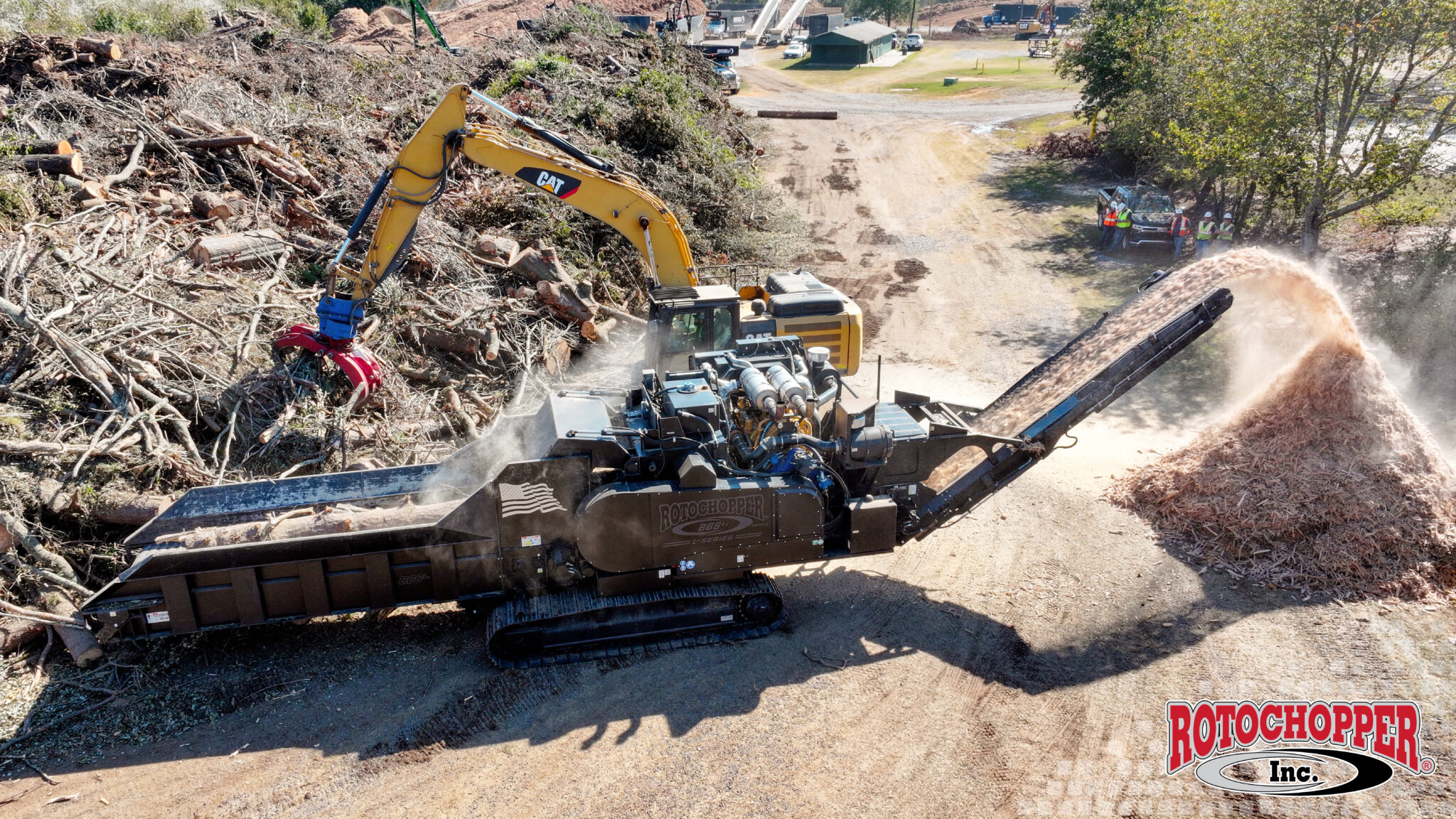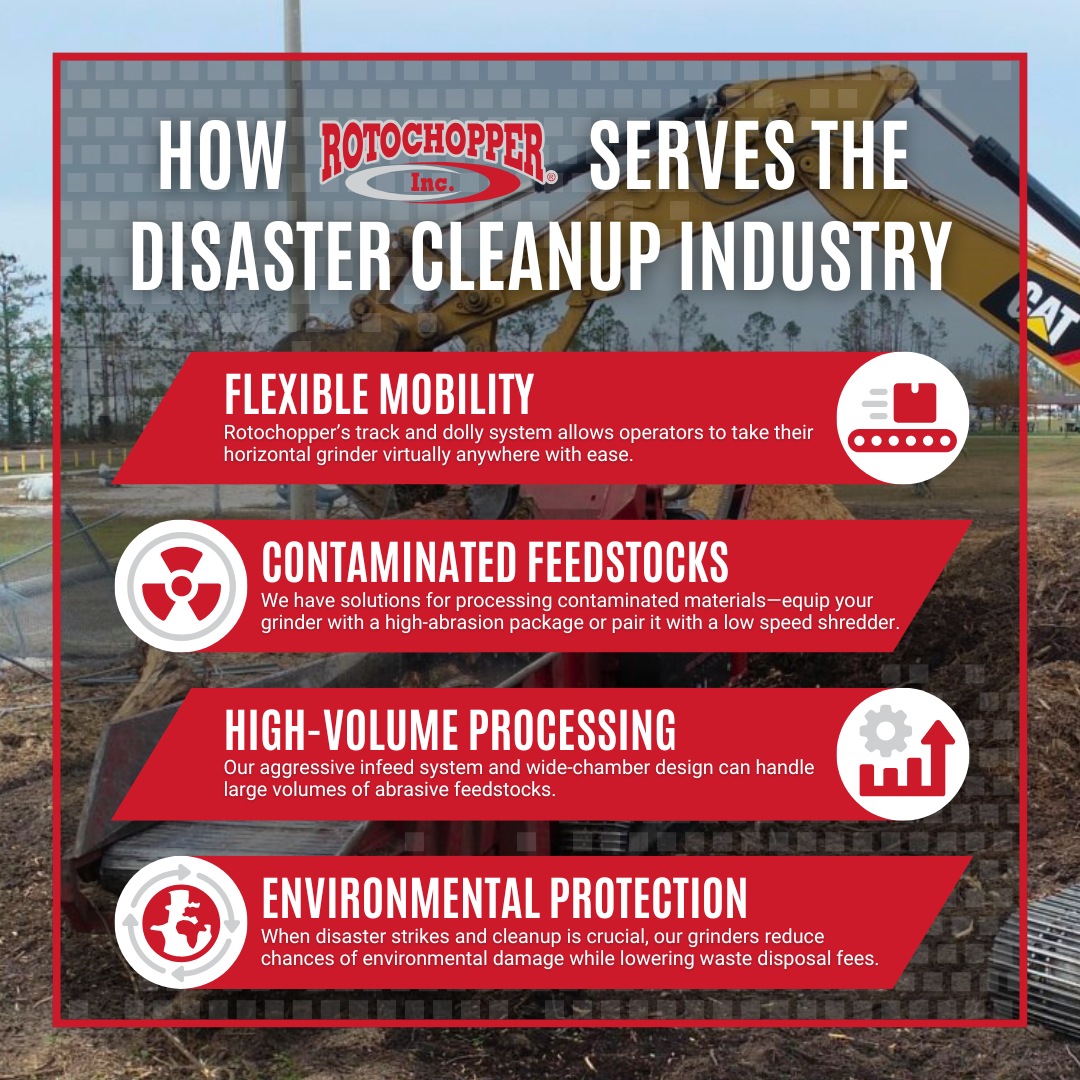
The storm damage debris cleanup industry plays a critical role in helping our communities recover from natural disasters like floods, tornados, hurricanes, and heavy storms. When these events strike, they often leave behind massive volumes of potentially contaminated waste and debris that can pose a hazard to residents, search and rescue teams, and the local environment. Without proper cleanup, this waste can eventually contaminate soil and groundwater, damaging wildlife habitats and harming the local economy and supply chain.
That’s where disaster debris cleanup teams come in. Using cutting-edge storm debris recycling equipment, these teams clear dangerous debris, dispose of hazardous waste, and support storm recovery efforts. Storm debris grinders and waste shredders are an integral part of a well-functioning debris recycling system, allowing cleanup specialists to remove debris and transport it off site, as well as separate recyclable waste from contaminants like metal.
The Challenges of Disaster Debris Cleanup
Storm cleanup specialists face unique challenges in their field, as the debris they’re moving isn’t pre-processed and can be extremely contaminated. Storm debris is often a mix of wood waste, concrete, metal, green waste, shingles, and more.
Depending on the severity of the disaster, storm debris cleanup specialists may also have to contend with rough, uneven terrain and flooding. Traditional wheeled machines may not be able to navigate these landscapes, so specialists often rely on tracked machines to ensure they can access potentially contaminated waste in hard-to-reach areas.
Despite the high volume, potential contamination, and difficult terrain, disaster debris cleanup projects are often conducted on tight timelines to minimize the amount of time residents and local businesses are displaced. Even after debris is collected, cleanup specialists need to transport large volumes of material while adhering to strict disposal regulations. Transporting such a large volume in its full form would be prohibitively costly and time-consuming, so specialists use storm damage recycling equipment to downsize material, minimizing costs and making it easier to dispose of—on-time and in accordance with federal, state, and local regulations.
How Rotochopper Serves the Disaster Debris Cleanup Industry
Rotochopper supports the disaster debris cleanup industry by manufacturing a range of storm damage grinders, wood waste grinders, shredders, and more. As a factory-direct manufacturer, Rotochopper understands the need for efficient, versatile, and reliable storm debris recycling solutions, and we’ve refined our equipment to meet the challenges of the industry.
Flexible Mobility
Rotochopper storm damage and wood waste grinders are built to handle rough terrain. With our track and dolly system, cleanup specialists can take their grinder anywhere—without wasting time transporting large volumes of dangerous waste to and from their grinder. Our track and dolly system works with both road tires and tracks and can switch between them in minutes, eliminating the need to load and unload your equipment when transporting it to and from the worksite.
High-Volume Processing
At Rotochopper, we understand that time is of the essence for disaster cleanup specialists. Our storm debris and wood waste grinders utilize an aggressive infeed system and wide-chamber design that can handle large amounts of even the most abrasive feedstocks, including shingles, brush, green waste, or even whole trees. Thanks to our team’s unrelenting dedication to quality engineering, our equipment’s exceptional power and versatility don’t compromise its longevity—our clients can take on even the toughest jobs with confidence their equipment will see them through.
Contaminated Feedstocks Processing
Because of the nature of storm damage, feedstocks are typically contaminated by metal and other un-grindable materials. Rotochopper’s wood waste and storm debris grinders can be equipped with optional ferrous metal removal systems that efficiently separate small metal contaminants from end products.
For optimal results, cleanup specialists can pair their Rotochopper grinder with one of our versatile shredders. When confronted with highly contaminated feedstocks, shredders equipped with a cross-belt magnet can filter out un-grindable material before it reaches the main grinder, reducing impact-related downtime.
In addition, our high abrasion package features numerous innovative designs that reduce wear on the grinder—including specialized drum and infeed designs that minimize spillage and focus wear on replaceable wear parts, rather than permanent fixtures like grinding walls and infeed rollers.
Our storm debris grinders can further minimize downtime and maximize efficiency with optional technology like our proprietary StopWatch monitoring system, which stops and reverses the grinder infeed when un-grindable materials are detected.
Save Money—and the Environment
Rotochopper storm damage recycling equipment helps cleanup specialists reduce waste volume for easy and efficient transport. When used as part of a larger disaster cleanup system, our storm damage and wood waste grinders reduce the chances of environmental contamination while minimizing transport and disposal fees.
Rotochopper’s Storm Debris Cleanup in Action
You don’t need to take our word for it—check out this video showcasing Rotochopper equipment in action.
Get Started with Rotochopper
Rotochopper is proud to support safe and effective disaster debris cleanup with reliable, versatile, and effective equipment. With Rotochopper storm debris recycling equipment, communities in need can recover from even the most destructive storms—faster, safer, and more effectively.
If you’re interested in learning more about Rotochopper and our equipment, contact one of our sales representatives.

